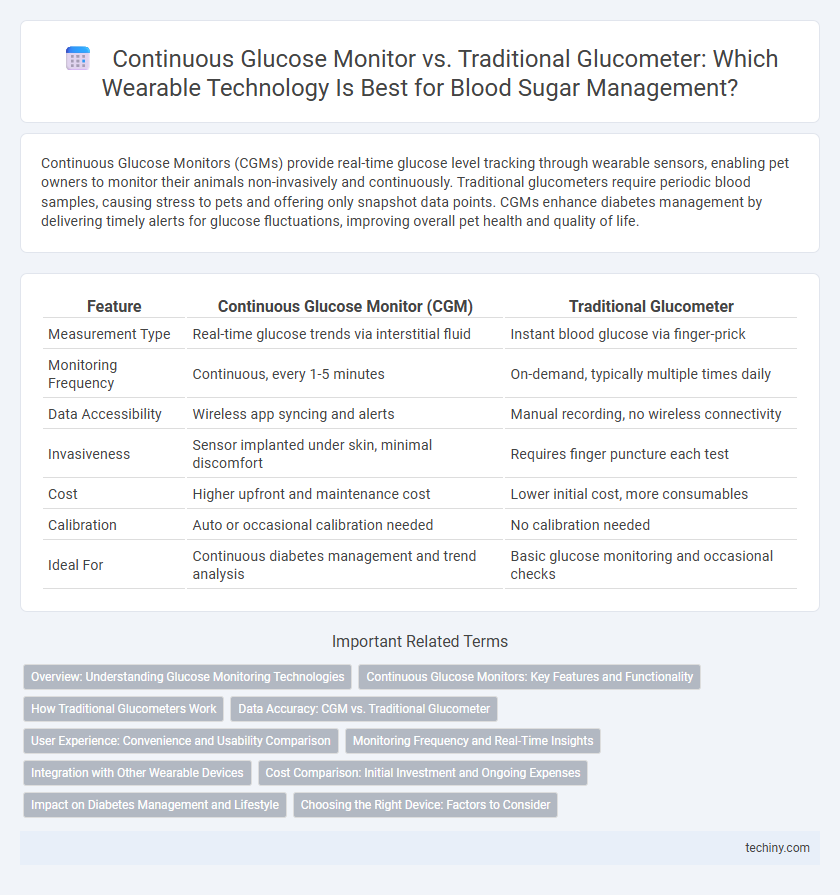Continuous Glucose Monitors (CGMs) provide real-time glucose level tracking through wearable sensors, enabling pet owners to monitor their animals non-invasively and continuously. Traditional glucometers require periodic blood samples, causing stress to pets and offering only snapshot data points. CGMs enhance diabetes management by delivering timely alerts for glucose fluctuations, improving overall pet health and quality of life.
Table of Comparison
| Feature | Continuous Glucose Monitor (CGM) | Traditional Glucometer |
|---|---|---|
| Measurement Type | Real-time glucose trends via interstitial fluid | Instant blood glucose via finger-prick |
| Monitoring Frequency | Continuous, every 1-5 minutes | On-demand, typically multiple times daily |
| Data Accessibility | Wireless app syncing and alerts | Manual recording, no wireless connectivity |
| Invasiveness | Sensor implanted under skin, minimal discomfort | Requires finger puncture each test |
| Cost | Higher upfront and maintenance cost | Lower initial cost, more consumables |
| Calibration | Auto or occasional calibration needed | No calibration needed |
| Ideal For | Continuous diabetes management and trend analysis | Basic glucose monitoring and occasional checks |
Overview: Understanding Glucose Monitoring Technologies
Continuous Glucose Monitors (CGMs) utilize real-time sensors implanted under the skin to provide constant tracking of blood glucose levels, unlike traditional glucometers that require intermittent finger-prick blood samples. CGMs offer advantages in managing diabetes by delivering detailed glucose trends and alerts for hypoglycemia or hyperglycemia, enhancing patient awareness and control. Traditional glucometers remain widely used due to their portability, affordability, and immediate point-in-time measurements despite lacking continuous data integration.
Continuous Glucose Monitors: Key Features and Functionality
Continuous Glucose Monitors (CGMs) provide real-time glucose readings through a small sensor placed under the skin, offering continuous data that helps in proactive diabetes management. These devices feature Bluetooth connectivity, enabling seamless data transmission to smartphones and cloud-based apps for detailed trend analysis and alerts. Unlike traditional glucometers, CGMs reduce the need for frequent finger pricks and improve glycemic control by detecting glucose fluctuations before symptoms arise.
How Traditional Glucometers Work
Traditional glucometers measure blood glucose by using a small drop of blood, typically obtained via a finger prick, that reacts with an enzyme-coated test strip producing an electrical signal proportional to glucose concentration. The device then interprets this electrical current to display the user's blood sugar level, providing quick but discrete readings. Unlike continuous glucose monitors, traditional glucometers require manual testing and do not offer real-time glucose tracking or trend data.
Data Accuracy: CGM vs. Traditional Glucometer
Continuous Glucose Monitors (CGMs) provide near real-time glucose readings with higher frequency and granularity compared to traditional glucometers, enhancing data accuracy for trend analysis and timely interventions. Traditional glucometers rely on intermittent blood samples, which may miss fluctuations and result in less comprehensive data. Advanced sensor technology in CGMs reduces measurement variability, enabling more precise glucose management for diabetes patients.
User Experience: Convenience and Usability Comparison
Continuous Glucose Monitors (CGMs) provide real-time glucose readings without finger pricks, significantly enhancing convenience and reducing user discomfort compared to traditional glucometers. CGMs offer seamless data tracking through smartphone integration, enabling trend analysis and proactive glucose management, while traditional glucometers require manual testing and logging. The usability of CGMs supports continuous monitoring and better glycemic control, making them preferable for users seeking a less intrusive and more data-rich experience.
Monitoring Frequency and Real-Time Insights
Continuous glucose monitors (CGMs) provide real-time glucose readings every few minutes, enabling users to track fluctuations seamlessly throughout the day, while traditional glucometers require manual testing at specific times, often missing crucial glucose trends. CGMs offer continuous data that enhance proactive diabetes management by alerting users to rapid glucose changes, whereas glucometers only deliver snapshot readings with delayed feedback. This real-time monitoring capability significantly improves glycemic control and reduces the risk of hypo- and hyperglycemic events compared to intermittent glucometer measurements.
Integration with Other Wearable Devices
Continuous glucose monitors (CGMs) offer seamless integration with wearable devices such as smartwatches and fitness trackers, providing real-time glucose data and trend analysis through synchronized apps. Traditional glucometers lack Bluetooth connectivity and often require manual data entry, limiting automated health tracking and comprehensive metabolic insights. This integration enables proactive diabetes management by combining glucose monitoring with activity, heart rate, and sleep data for personalized health optimization.
Cost Comparison: Initial Investment and Ongoing Expenses
Continuous Glucose Monitors (CGMs) typically require a higher initial investment, ranging from $1,000 to $1,500 for the device, compared to $20 to $50 for a traditional glucometer. Ongoing expenses for CGMs include sensor replacements every 7 to 14 days, costing approximately $300 to $500 per month, whereas traditional glucometers incur lower continuous costs through test strips priced at $0.50 to $1 each. The long-term cost-effectiveness of CGMs is influenced by improved glucose management and potential reduction in diabetes-related complications.
Impact on Diabetes Management and Lifestyle
Continuous glucose monitors (CGMs) provide real-time blood sugar data through wearable sensors, enabling better glucose control and reducing hypoglycemic events for diabetes patients. Unlike traditional glucometers that require finger-prick tests at specific times, CGMs allow seamless glucose monitoring throughout the day, improving lifestyle flexibility and decreasing the burden of frequent manual testing. Enhanced glucose data insights from CGMs contribute to personalized treatment adjustments and more effective diabetes management strategies.
Choosing the Right Device: Factors to Consider
Continuous Glucose Monitors (CGMs) provide real-time, dynamic glucose readings with greater convenience and less pain than traditional glucometers, which require finger-prick blood samples. Key factors to consider when choosing include accuracy, frequency of monitoring, lifestyle compatibility, and cost, as CGMs typically offer continuous data at a higher expense, while glucometers provide discrete, manual measurements. Users with diabetes should evaluate their specific needs for glucose tracking, data accessibility, and ease of use to select the most effective device for maintaining optimal glycemic control.
Continuous Glucose Monitor vs Traditional Glucometer Infographic

 techiny.com
techiny.com